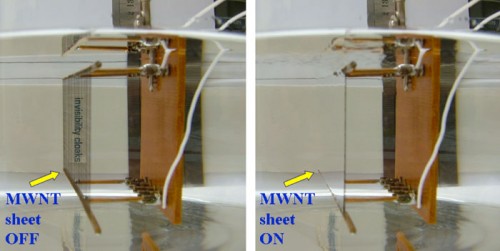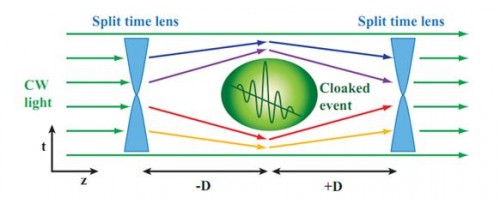
Uncle Sam needs a makeover.
The U.S. Army’s current uniform, called the Universal Camouflage Pattern (UCP), was intentionally designed to effectively hide its wearers in all environments. But instead, the pixelated clothing failed everywhere, earning the ire of everyone from camouflage developers to soldiers, who complained that the uniform only worked “in a gravel pit,” as some news sources have reported. While the Army has gone through a variety of camouflage options, a new kind of technology altogether may emerge as the uniform of choice — real-life invisibility cloaks.
Hyperstealth Biotechnology Corp develops camouflage that has been used by 31 different countries, including the U.S. Last year, Activision even used their “ghostex” pattern in the popular game Call of Duty®: Black Ops II. However, the company did not enter the public consciousness until late 2012, when major media outlets like CNN began reporting that a Canadian company had developed an “invisibility cloak.”
Guy Cramer, the CEO of Hyperstealth, claims that a soldier wearing his high-tech Quantum Stealth material would be undetectable “unless you walked right into him.” According to Hyperstealth’s website, Quantum Stealth material bends light waves around whoever is wearing it, removing his or her visual, infrared, and thermal signatures. Quantum Stealth also conceals the target’s shadow. In short, Quantum Stealth would put Harry Potter’s invisibility cloak to shame.
Cramer swears that representatives from the Pentagon have seen the material first-hand, confirming that it indeed is undetectable by infrared scopes. However, “for reasons of security,” Cramer refuses to explain the science behind the invisibility cloak. Still, if the Quantum Stealth material is even half as effective as Hyperstealth claims it is, it will mark one of the biggest leaps forward in “invisibility cloak” technology.

Moving from Science Fiction to Reality
The first instance of a working invisibility cloak was demonstrated at Duke University in 2006. Professor Sir John Pendry from Imperial College London worked with researchers at Duke to create a cloak that could deflect microwaves around an object. Similar to the way river water flows around a rock, the electromagnetic waves flowed around the cloaked object instead of hitting the object directly.
The key to Pendry’s breakthrough lies in something called metamaterials — man-made materials that are specifically engineered to have unique geometry and special properties. The metamaterials used in Pendry’s cloak look like concentric two-dimensional rings, shaped to grab and deflect electromagnetic waves. Despite the fact that the cloak only partially deflected microwaves, not visible light, and that it worked only in two dimensions, it was widely hailed as a groundbreaking discovery. The research was so well-received that Pendry was later elected into the American Academy of Arts and Sciences, joining an intellectual fraternity that includes Thomas Jefferson, Jonas Salk, Hilary Clinton, and Yale Applied Physics Professor Paul Fleury.

The Illusion in Our Minds
Another major breakthrough came five years later, when a group of scientists at the University of Texas at Dallas created a cloak that could actually hide objects from the naked eye. Their design relied on sheets of carbon nanotubes (CNTs) — incredibly thin sheets of cylindrical carbon tubes that, when heated, possess a property similar to straws in water or the “mirage effect” demonstrated by hot desert sand.
When a straw is placed in a cup of water, it seems to bend upwards. This is due to the refractive index of water being greater than that of air. Since the angle of light is greater when the refractive index is greater, the light waves go from steep to shallow as they move from water to air. But because our line of sight is straight, we do not take into account the bending of the light and think instead that the straw is bent.
In deserts, the opposite phenomenon occurs. The air closest to the ground is hotter than the air above it, and the denser cold air possesses a greater refractive index than the warm air below it. Thus, when light rays pass from hot air to cold air, they are bent concavely, growing steeper as they move from hot to cold air. The greater the difference in temperature between the hot and the cold air, the more the light is refracted and the greater the angle of refraction, or difference in angle between the light waves in hot air and the light waves in cold air. When the light rays finally reach the human eye, the brain sees the reflected sky instead of sand dunes, and interprets this misleading image as water.
If CNTs are heated to high temperatures, they can create a similar temperature gradient. When light rays reach the sheet, they are refracted — bent away from the object hidden by the CNTs, rendering it invisible to our easily-fooled brains. Although the nanotubes impractically only created an effective temperature gradient when immersed in water too impractical for day-to-day use, this discovery marked one of the first instances of true optical cloaking.

The Future of Invisibility
The discovery was far from being the last, however. In 2011, physicists at China’s Southeast University developed an ultrathin invisibility cloak with the ability to hide electric currents. Last year, UC Berkeley engineers published research on a silicon oxide- and silicon nitride-based cloak that uses the different materials’ refractive index to shield objects roughly the size of a red blood cell. And just a few months ago, Sir Pendry and his team at Duke made a new development: a diamond-shaped invisibility cloak that can hide an object from electromagnetic waves without any reflections.
While these advancements in optical invisibility cloaks are truly remarkable, researchers at Cornell have set their sights upon an even more ambitious project: Last year, Professor Moti Fridman and his colleagues developed something they called “temporal cloaking”— essentially, the creation of a time hole. Using a split time-lens, they separated light into slower waves and faster waves. Then, using another split time lens, the separated waves were pieced back together. As a result, though the light that enters is identical to the light that emerges from the lenses, there is a time gap between the lenses in which any event that occurs is unseen. Anything that happens within those lenses during the time it takes the light to go from the first lens to the second is hidden.
Unfortunately, Fridman and his colleagues were only able to cloak periods of 0.00012 seconds, not nearly enough time for a thief to rob a bank. However, if the time period were to be extended to microseconds or milliseconds, ultra-secure messages could be hidden in the temporal cloaks. While there may not be a big market for microsecond temporal cloaking among the general public, this technology has definite military applications, especially as countries upgrade their security to deal with the advances of the information age.
This brings us back to why the topic of invisibility came about in the first place: Quantum Stealth. Is it the real deal? Will the U.S. Army outfit itself in a new one-size-fits-all uniform, a camouflage so effective that the enemy would have to bump into our soldiers to realize their presence?
The brief history of cloaking breakthroughs suggests that we most likely will not see G.I.s suit up in invisible fatigues this year or the next. However, as more research teams jump into the field, other, less militaristic applications of this growing technology could become possible.
Metamaterials could be used to deflect and concentrate sound waves, allowing doctors to use this sound beam to destroy tumors without hurting anything else, and invisibility cloaks could be used on organs and tissue, improving medical imaging by selectively hiding tissue so that the diseased organ can be seen more clearly. As applications continue to develop, it may only be a matter of time before we fully harness the power of invisibility.
Just as we mastered flight, space travel, and other abilities thought to exist only in science fiction, we are headed towards conquering the next great frontier.
